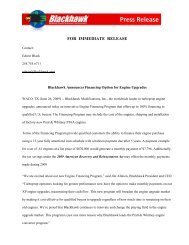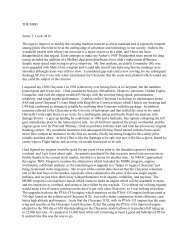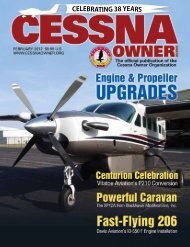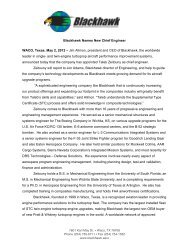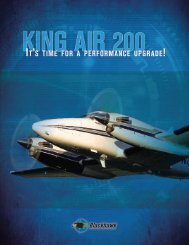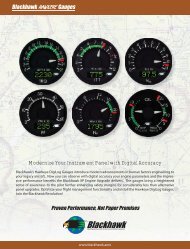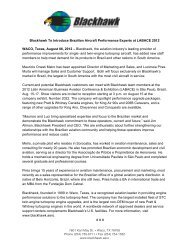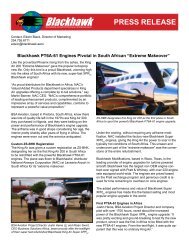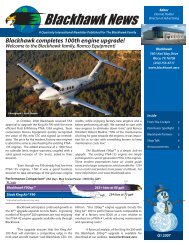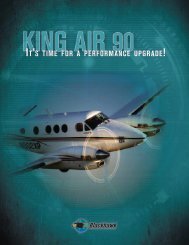Blackhawk News Q2 2008 (.PDF) - Blackhawk Modifications, Inc.
Blackhawk News Q2 2008 (.PDF) - Blackhawk Modifications, Inc.
Blackhawk News Q2 2008 (.PDF) - Blackhawk Modifications, Inc.
You also want an ePaper? Increase the reach of your titles
YUMPU automatically turns print PDFs into web optimized ePapers that Google loves.
EditorLeigh DavisA Quarterly International <strong>News</strong>letter Published For The <strong>Blackhawk</strong> Family<strong>Blackhawk</strong>’s position as the worldwide leader in certified Pratt & Whitney PT6A engine upgrades continues to grow. ThePT6A-52 engine, selected by Hawker Beechcraft to power the new B200GT model, is the latest addition to <strong>Blackhawk</strong>’sportfolio of King Air 200/B200 engine upgrades. Fully certified since April and with -52s now in service, operators areseeing typical cruise speeds in excess of 310 KTAS. The impressive performance gains of the Super XP52 and SuperXPR61 upgrades are the reason new engines are quickly becoming the preferred solution to traditional overhaul. KingAir 200 operators looking to phase out the old PT6A-41 engines have an additional option to choose between the PT6A-42, PT6A-61 or the PT6A-52, whichever level of performance and value best fits their operational needs.<strong>Blackhawk</strong>7601 Karl May DriveWaco, TX 76708(254) 755-6711www.blackhawk.aero<strong>Blackhawk</strong> has already recorded a record number of bookings in <strong>2008</strong> and is working on some exciting new programsthat will continue this trend into 2009. If you are approaching overhaul, or would enjoy a boost in performance, contact<strong>Blackhawk</strong> today to see what plans we have on your horizon.Inside This IssueFrom The CockpitOwner ShowcaseDistributor SpotlightShop Talk2234“With twelve horsepower at our command, we considered that we could permit the weightof the machine with operator to rise to 750 or 800 pounds, and still have as much surpluspower as we had originally allowed for in the first estimate of 550 pounds.”Orville WrightA few candid shots from Superior Aircraft Maintenance.Read more about Superior in our Distributor Spotlight, page 3.<strong>Q2</strong> <strong>2008</strong>
<strong>Blackhawk</strong> <strong>News</strong>Flight TrainingAbout 10 years ago I attended a refresher course torenew my type rating on the Citation IISP at a simulatorbased training center the Dallas/ Fort Worth area. I hadn’tflown the Citation in several years so to say I was “rusty”was an understatement. Ground school went fine. I havealways had a good grasp of how airplanes work and enjoyedrefreshing my knowledge of the systems and procedures offlying the airplane. The trouble came when I stepped intothe FTD (Flight Training Device) also known to some as anon-motion simulator also known by a few other verycolorful metaphors.Flight Simulators do a very good job of training a pilot tohandle emergencies that would otherwise be unsafe toduplicate in flight in an actual aircraft. The problem is thatolder simulators tend to be a little slow on the response sideso you have to teach yourself to “fly the computer” insteadof the airplane, which makes you over or under correct a bituntil you get used to how the simulator “flies”. My instructorwas a curmudgeonly ex-airline pilot who actually hadvery little time in a Citation but quite a bit of time in largeturboprop aircraft. He was a little on the grumpy side andtended to chastise me with great fervor every time I madethe slightest error – and boy was I making some errors! Themore he yelled at me the madder I got and the worse I flew.It quickly became evident that I was paying this company alot of money to get yelled at and I wasn’t learning anything.Finally in frustration I demanded that he “freeze” thesimulator. I then explained to him in very clear words that Iwasn’t paying this company to berate me. I was payingthem to train me and right now I wasn’t being trained. I said“either you start training and stop yelling” or we will go talkto your supervisor and get another instructor assigned tome.He sat there for several minutes before he finally said,“OK”. We went back to some basic maneuvering with himtelling me how to set the plane up for different proceduresOwner ShowcaseBert Bollar, BB-1331The Ideal Engine for the King Air 200One would think that after sitting in the left seat of a KingAir B200 for over 8,000 hours, anything would be a moreappealing conversational piece. But veteran King Air pilotBert Bollar has renewed his zeal for the celebrated King Airafter flying with his Super -61 XPR powered aircraft. Basedin Jackson, Wyoming, Bollar is always on the lookout forways to spruce up his King Air. He immediately recognizedthe upside of the highly efficient Pratt & Whitney PT6A-61engines and the positive impact it would have on TetonAviation’s operations. Bollar reserved his engine deliveryposition before the STC was awarded in 2007 and installedthe -61 engines when they became available in February,<strong>2008</strong>. With over 100 hours on his new engines, he insiststhe hype was worth the wait.Jim Allmon, CEO & President of<strong>Blackhawk</strong> <strong>Modifications</strong>, is anexperienced pilot with 8000hours total time and more than25 years experience in aviationsales and marketing.to make single pilot jet operations safer and easier tomanage. He began to train me. I began to learn and the ruststarted coming off in great chunks. By the end of the coursehe awarded me a “Wings Program” level and I had theconfidence of knowing I could handle any emergency thatmight come along in a Citation.Since that experience, I have gone back to the sametraining center every year for a multitude of aircraft that Ifly. I cannot stress how important it is to go to annualrecurrent or initial pilot training for your aircraft. You shouldnever view this training as a pass or fail test. It is a learningexperience that once completed, gives you a whole newconfidence in your aircraft and your abilities. I have hadmany different instructors over the years and every one ofthem has exhibited the highest professionalism and knowledgeof whatever aircraft I was training in. They take thetime to point out not just what I did wrong, but how tocorrect it and then let me try it again and again until I got itright.A really good instructor does not berate and chastise. Heor she finds what your weak points are and works with youto strengthen them and hone your skills so that on somedark dreary cold night when you are alone in the cockpitand things go wrong as they sometimes will, you are atrained pilot able to deal with the situation and get youhome with an unscratched airplane and unstained underwear.Happy Vapor Trails.Speaking about his newly upgraded King Air (BB-1331),Bollar said,”I’m convinced the -61 engine is the ideal motorfor the King Air 200. You couldn’t put a bigger engine on orit would be a waste of power. In upper flight levels, we areconsistently 8 to 10 knots below the barber-pole at recommendedcruise settings. If we hit a mountain wave, we haveto pull back the power or we will shoot past the red line.”Teton Aviation’s King Air has gotten the VIP treatment foryears. The company’s approach to new technology forairplanes is similar to how they view technological advancementsin the cars they drive. They routinely upgrade to takeadvantage of the latest advancements in safety andcomfort. This is evident in the various aerodynamic andavionic upgrades they have installed since their King Air waspurchased 11 years ago. Bollar feels it is easy to justifyinvesting in their heavily used King Air when better performanceand a higher valued airplane is the result. Even with1,250 hours of time remaining to overhaul on their original
Shop TalkMike Moore, Technical Services Managermike@blackhawk.aeroYou Have My Low Idle Set Way Too High!We get a lot of complaints from new XP Engine Upgradeowners who are changing from a 3-blade propeller to a4-blade propeller about the speed which their newlymodified aircraft now taxies. Most owners who haveoperated 4-blade props have already been through thelearning curve but here is some additional information youmay not be aware of.All 4-blade props (Hartzell & McCauley) have a minimumRPM operating restriction; this is due to a specific vibratoryresonant condition known as a “reaction-less mode”.During operation in these conditions, the flight crew cannotfeel the resulting high propeller vibration. Ground operationat or near an RPM that can cause a reaction-less modevibratory resonance can cause very high stresses in thepropeller blades, blade clamps, and hubs. These highstresses are more severe when operating in a tailing windcondition.If the propeller is operating within a restricted RPM rangeor below a minimum idle RPM restriction for an extendedperiod of time, the propeller blades, blade clamps and hubcan become “unairworthy” due to fatigue. A failed blade,blade clamp or hub has the potential of causing acatastrophic event because of blade separation. Hartzellservice letter HC-SL-61-254 and McCauley service letterSL2005-7, which is included with your <strong>Blackhawk</strong> datapackage, goes into detail on this subject and gives instructionson what to do if the propellers have been operatedbelow the minimum RPM.I bring up this subject so aircraft owners, operators andmaintenance facilities have a better understanding of the<strong>Blackhawk</strong> rigging procedure intensions, which is to set theengines so they cannot be operated below these minimumRPM requirements. The installation instructions for someSTCs simply instruct themechanic to adjust theengine low idle (Ng RPM) toobtain the minimum propRPM.Our new Super XPR61 STChas a detailed rigging proceduremanual and it instructsthe mechanic to set the NgRPM to 61 to 63% which should produce the minimum propRPM. The drawback to either of these or any low idle settingis that atmospheric conditions greatly affect the operationof the PT6A engine and as so changes the low idle settingfrom one day to the next and/or one airport to the next. Soit is possible to adjust the low idle so the prop RPM is wellabove the minimum on that day at that airport and the nextday or at the next airport the RPM is too low. So it is theresponsibility of the pilot to know what the minimum RPMrestriction is and make sure that he keeps the RPM abovethat minimum.It will be necessary to pull the power levers into ‘groundfine’ for some taxi operations to keep the speed to aminimum. Ground fine is a ‘dead band’ of power lever travelbetween low idle and reverse. This dead band allows thepropeller to travel to a flat pitch before the fuel control unitstarts to schedule fuel to increase power and the prop goesinto reverse pitch. Even aircraft without a ground finedetent on the power lever quadrant should have a deadband of power lever travel just after the power lever ispulled up and into reverse. If you have any aircraft operationalquestions our chief pilot Chris Dunkin would behappy to discuss them with you. For engine installation orrigging questions I’m always happy to help.<strong>Blackhawk</strong> <strong>Modifications</strong>, <strong>Inc</strong>.7601 Karl May DriveWaco, TX 76708 USA(254) 755-6711www.blackhawk.aeroOn The HorizonEAA (Oshkosh) • NBAA (Orlando) • Turboprop Expo (Scottsdale)<strong>Blackhawk</strong> <strong>News</strong>



